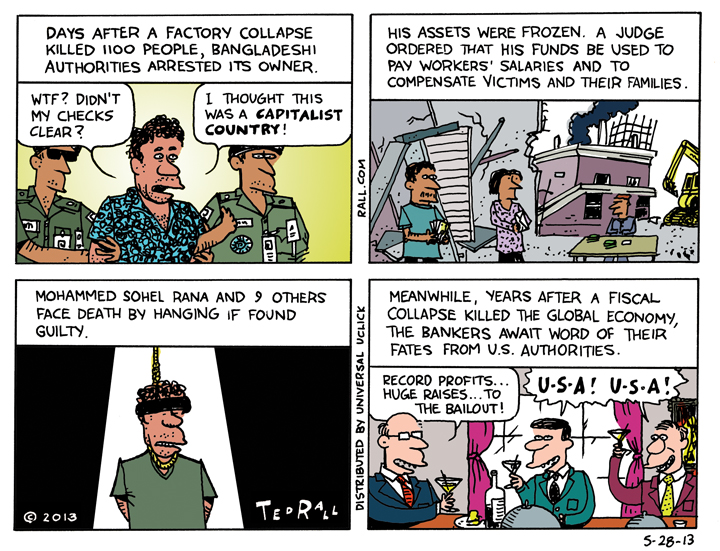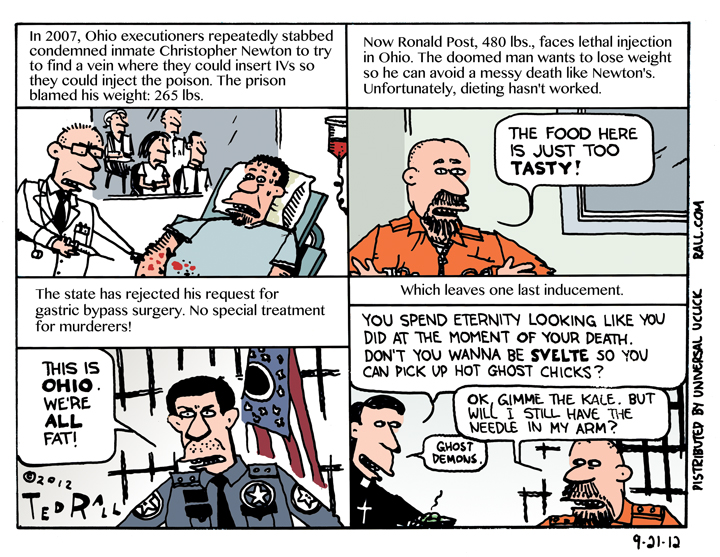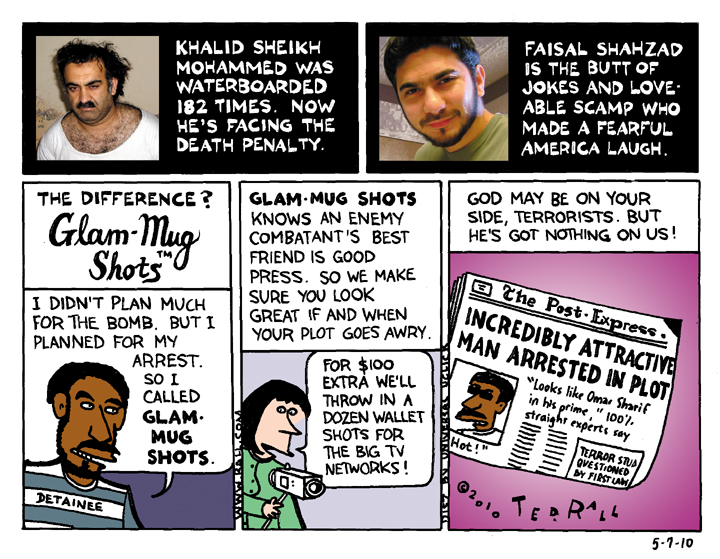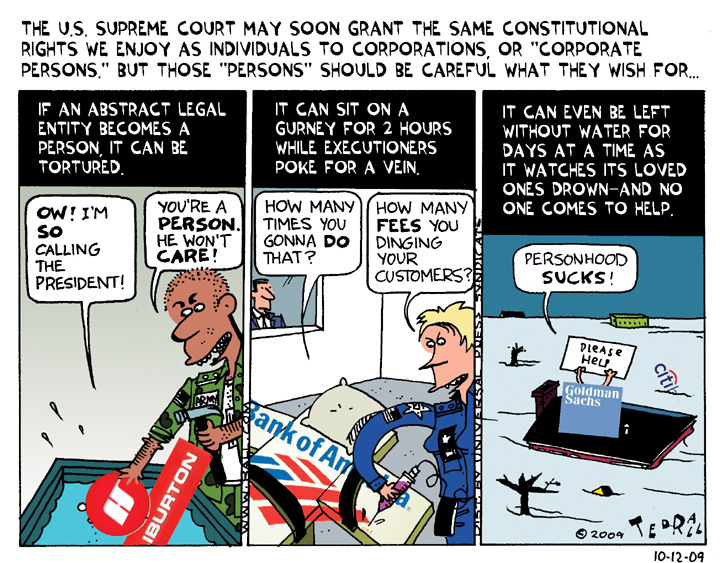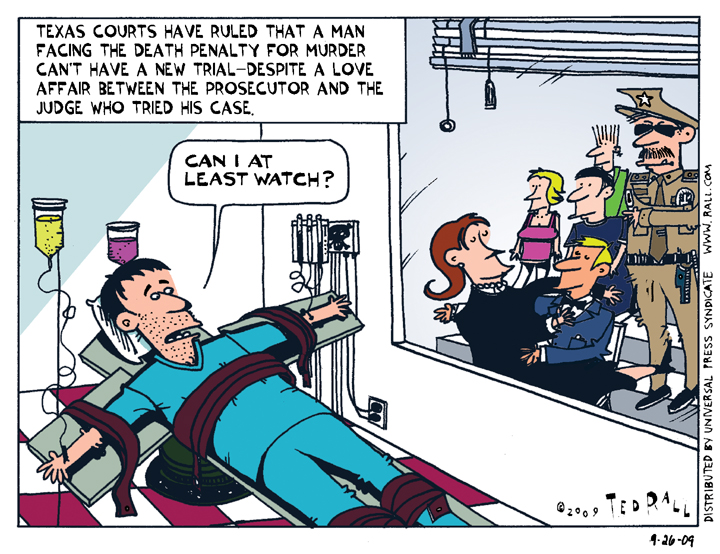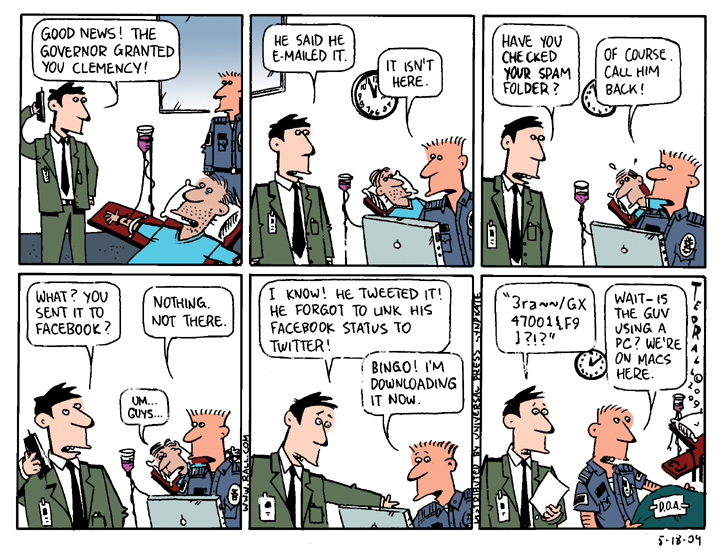Bangladesh isn’t some crappy Third World country like the United States, where capitalists can crash the economy and get away clean – and loaded.
SYNDICATED COLUMN: You Kill Me, They Kill You
Our Love Affair with Official Mass Murder
On the evening of Wednesday, January 8, while most Americans were trying to choose between “Wings” and “Beverly Hills, 90210,” Kirt Wainwright lay strapped to a metal gurney, both of his arms stretched out like a man awaiting crucifixion, as a small group of witnesses gawked at him through a one-way mirror from an adjoining room. Nurses employed by the taxpayers of the State of Arkansas stuck needles into each arm and prepared to release poison—a mixture of sodium pentothal, Pavulon and potassium chloride, if you want to try this at home—into his veins.
At the last minute, Justice Clarence Thomas, a letch who rose to the Supreme Court thanks to the affirmative action programs he opposes, requested a temporary postponement of the execution while he analyzed a potential conflict of interest (Arkansas governor Mike Huckabee, who rejected Wainwright’s request for a stay, knew both of his victims).
Meanwhile, Wainwright remained splayed across the death gurney, the needles still in his arms.
About 45 minutes later, Thomas decided not to intercede, and the lethal injection went forward as planned. Try to imagine, if you can, the psychological roller-coaster ride that our legal system put this man through. There you are, ready to die, only to be offered a glimmer of hope. But they don’t cut you loose, they don’t give you a cigarette, they don’t let you pace around. You’re totally crazy with terror, strapped down, those needles itching, watching the seconds go by—then the minutes—one by one, passing incredibly slowly and quickly, both at the same time. Then, like some twisted junior-high-school joke (“You’re saved…not!”), it’s all over anyway. Game over.
Prison spokesperson Dina Tyler, was asked if it might have been more humane to remove the needles while Thomas deliberated his fate. “I don’t know,” she responded.
The sickening spectacle of the Wainwright execution was too much even for many death-penalty advocates. For the first time since Gary Gilmore was offed by a Utah firing squad in 1977, the news media is giving the grisly routine of state-sponsored electrocutions, gassings, injections and shootings a second look.
Most advocates promote capital punishment as a deterrent to crime, but after two decades of state-run death it obviously doesn’t work. The most bloodthirsty states, Texas, Florida, Virginia and Louisiana, each throw an inmate to the gods once a week, but still have some of the highest crime rates in the nation—including for capital offenses.
Another pro-death argument is that it’s more economical to kill prisoners than to feed and house them. Following this rationale, however, would mean murdering everyone convicted of a crime, not just murderers. Moreover, the exploding rate of prison construction (it’s California’s fastest-growing industry) suggests that our society likes to keep a substantial portion of its population behind bars. Otherwise, why would we jail thousands of people for minor drug-related offenses?
The truth is, capital punishment is eye-for-an-eye vengeance, no different than the stonings that Taliban rule has brought to Afghanistan. They killed, so we kill them. And there’s no doubt that most of those who are executed deserve to die. For example, Kirt Wainwright was 22 when he robbed a convenience store in Hope, Arkansas (Bill Clinton’s hometown) in 1988. The clerk, Karen Ross, handed over the money, but he shot her to death nonetheless. The next day, he also murdered another store clerk, Barbara Smith, the same way. Neither Karen Ross nor Barbara Smith were offered an appeal. They never got to say good-bye to their families. The Supreme Court never heard their case. If anyone ever deserved to die like a dog, it was Kirt Wainwright.
Unfortunately, the way we carry out the death penalty—shrouded in secrecy, with even the executioners hidden from the condemned—isn’t consistent with our bloodlust. These executions are carried out by our criminal justice system, with our taxpayer dollars, and as such should be public affairs. They should be nationally-televised during prime time, and rated for children’s viewing. If we sanction state-sponsored death, then we should have the stomach to watch it while we eat our nachos. Why should we protect our kids from what we view as justice?
Not even the executioners take pride in their work. As Dina Tyler told the Associated Press, “By doing these together, you only have to make that climb once to get mentally prepared to do this. I think everybody gets a little tense. It gets a little quiet. You see a lot of set jaws as people steel themselves for what they’re about to do.” If what they’re doing is so right, why are they so tense? Also, why not hold executions annually, killing dozens of people at once to make it easier? They could be buried alive in large pits or thrown into an electrified swimming pool!
While it’s true that many killers deserve to die, it doesn’t follow that the state should kill them. Setting aside the question of judicial mistakes, it’s much less dangerous to let relatives of victims kill the killers—after all, they have a vested emotional interest in getting even. But the government is supposed to set the highest possible example for human behavior. The state should urge us all to be our best, not turn us all into de facto killers. Every other industrialized nation has realized this, which is why we’re the only First World country that still puts people to death. Maybe, if we stop now, the rest of civilization will still have us.
(Ted Rall, a syndicated editorial cartoonist and freelance writer based in New York City, is the author of Real Americans Admit: The Worst Thing I’ve Ever Done! (NBM Publishing, 1996).)
© 1997 Ted Rall, All Rights Reserved

